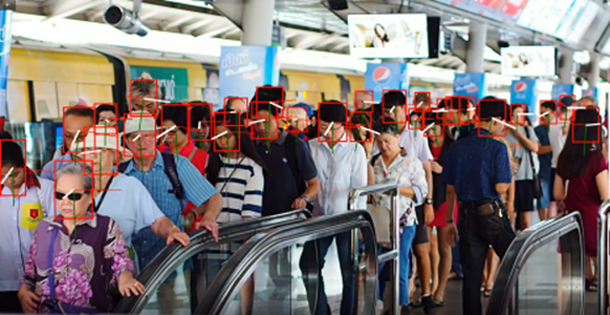Fujitsu AI analyses people movement and advertising effects
- February 18, 2020
- imc

Fujitsu has developed a system that uses artificial intelligence (AI) to analyse images from cameras placed around a city to provide information on people movements and the effects of advertising.
The Japanese company’s AI image analysis system measures and evaluates digital signage user experience. It detects viewers’ interests and behaviour to analyse advertising value while helping create a safe, comfortable neighbourhood
Called Greengages Citywide Surveillance v3, the privacy-conscious AI-based image analysis measures the impact of and engagement with advertisements in public places, such as digital signage, based on the number of viewers and their attributes.
Developed to create business models for public advertising and contribute to urban development with better understanding of user experience, it is relevant for ad agencies and advertisers, as well as facility managers for such large-scale facilities as train stations and airports to understand the target audience user experience.
Starting sales in Japan this month, the system will launch in Asia and Europe during the next fiscal year, starting in April 2020.
AI technology from Fujitsu analyses images from cameras placed around a city or in a facility without identifying the people in the images. It automatically extracts information on people and vehicles, capturing real-time movements throughout a city.
This smart city monitoring aims to create urban areas where people can live comfortably and with peace of mind, as it can also detect suspicious behaviour, such as surreptitious peeking. Features have been added to capture real-time actions and characteristics of groups of people, such as their viewing direction, gender and age, without identifying individuals.
These features aid advertisers in better understanding the frequency and level of engagement by viewers in public places, such as train stations, airports and shopping malls.
With this, Fujitsu aims to vitalise urban areas by creating business models for advertising in public places. Focusing on the viewers’ interests and behaviour, it will enable digital signage to be placed based on the number of viewers, and display dynamic advertising based on target audience viewing duration. It can also provide guidance information and optimised routing of population flows based on the characteristics of people entering a facility.
Since its first launch in October 2016, Greengages Citywide Surveillance has been used by security-related institutions, transportation infrastructure providers and corporations as image analysis software aiming to create comfortable and safe urban areas. In May 2018, its features were enhanced to support applications spanning a wide variety of city scenarios.
For example, beyond just detecting and measuring the number of people or vehicles, its detection features were expanded using AI technology to distinguish the characteristics of the clothes people wore as well as the colour, model and manufacturer of vehicles. In addition, a feature was added to deliver the analysis results through an API.
Applying this to other fields, Fujitsu has now launched version three to tackle the challenge of measuring the value of advertisements in public places.
It can calculate the number of people who pay attention to advertisements, the amount of time people look at them, and the viewership rate for advertisements by evaluating the viewing direction of large groups in videos taken from cameras installed near digital signage and billboards, without identifying specific individuals.
Moreover, based on factors such as the angle and direction of a person’s head, it can detect their viewing direction even when they are relatively small in the image or when their faces are not visible.
The technology is patent pending, and should let companies sell digital signage that can measure advertisement viewership numbers.
It can also measure the effect of guiding and optimising traffic through analogue and digital signage installed in public spaces, including on the street and in train stations, airports and shopping malls.
And it can detect suspicious behaviour, such as surreptitious peeking, thereby enhancing safety and security.
Without identifying individuals, it estimates the age and gender of people in crowds. Even when a crowd is milling about randomly in the street, when the individual people are quite small in the field of view, and even when their faces are not visible, it can estimate attributes based on physical characteristics such as hairstyle and clothes.





